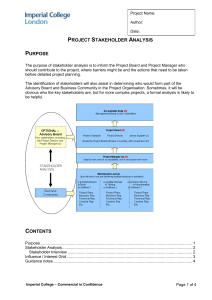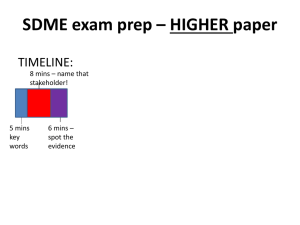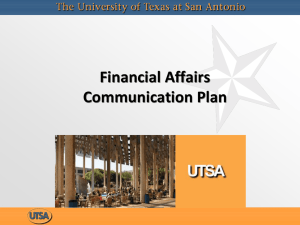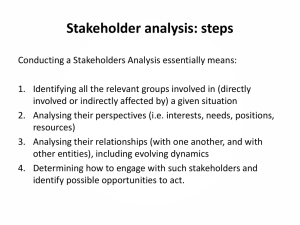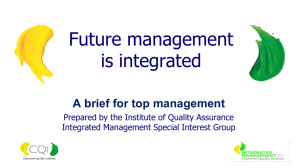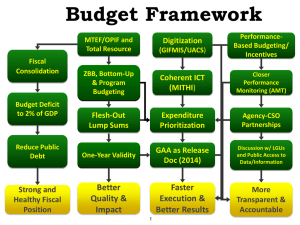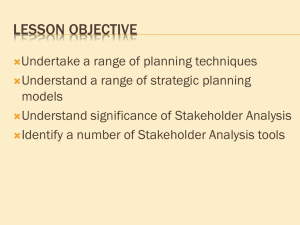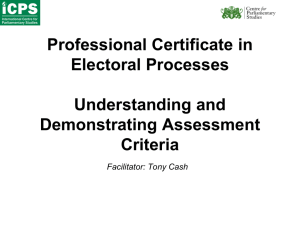Community Mobilization & Multistakeholder Engagement
advertisement
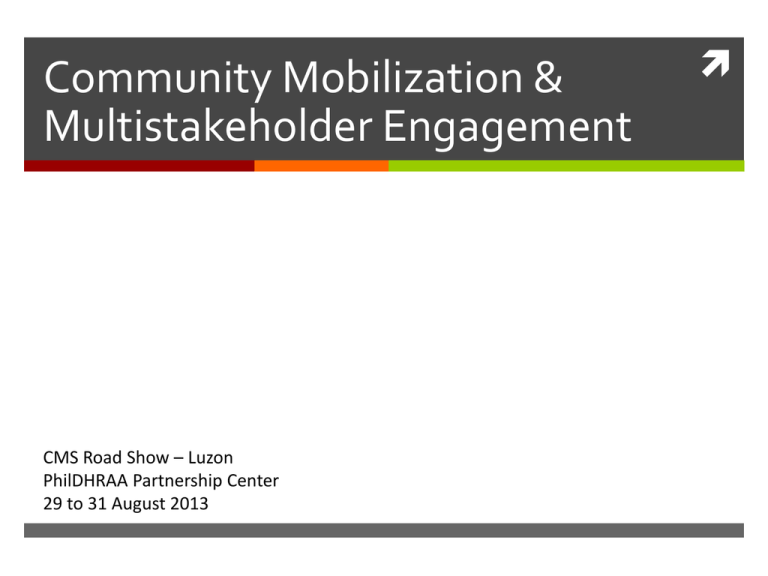
Community Mobilization & Multistakeholder Engagement CMS Road Show – Luzon PhilDHRAA Partnership Center 29 to 31 August 2013 Learning Objectives At the end of this session, you should be able to: Demonstrate increased knowledge of the principles of and key steps in community mobilization; Apply some tools for engaging different community stakeholders in collective action; Identify tasks in involving communities and some strategies to facilitate stakeholder engagement. Your Idea of a “Community” What comes to mind when you first hear the word “community”? What is a Community? A set of people that share any or all of the following: Territory Resources Language Culture Religion Occupation Interests Etc. We all belong to a community. What are some of the communities you belong to? What is a Community? People are the heart of a community. Heterogeneous Diverse needs Different motivations Diverse skills Various resources How do we bring them together and harness what they have to offer? Community Mobilization The process of building social relationships in pursuit of common community interests. Increases participatory decision-making processes by bringing diverse stakeholders into a common process Expands inclusion of often marginalized populations, such as women, youth, persons with disabilities, the elderly, and religious or ethnic minorities Depends on local resources, both human and material Fosters stronger relationships between local government, businesses, community members and CBO/NGOs Ensures local ownership of development Promotes a more active and informed citizenry Community Mobilization: Some Principles Participation When people are involved from design to implementation and assessment, ownership is high Context sensitivity Local solutions to local problems Empowerment, not dependence Communities as actors, not recipients Prepare: Get to know the community DO! Sustain WHAT, WHERE, WHEN? Steps in Community Mobilization Develop & execute a community action plan WHO? Involve stakeholders WHY? Issue analysis & community visioning 1. Get to Know the Community Core area of community development E.g., Livelihood, Maternal health, Public education Identify a common issue that the community can get involved in. Gather information on the community & the issue by: Talking to people in the community Talking to community leaders Conducting surveys, FGDs (formal) Plan for a community gathering or dialogue on the issue.* 2. Involve Stakeholders Decide who is crucial to involve Stakeholders: groups and individuals who Primary: are directly involved in the issue; can affect or are affected by the issue Secondary: intermediaries; can help facilitate awareness and understanding; can mobilize additional support or resources Be inclusive Core group of actors Roles E.g., Who would be a good infomediary/lea der? 3. Organize around an issue Identify and prioritize current underlying conditions What are the current problems in public education in the school? (Context) What causes these problems? (Cause) Which of these can we do something about? (Priorities) Develop a community vision How does a good public education system in our community look like? What key changes/improvements are in place? 3. Organize around an issue Vision - summarize your community’s dream for the future. The vision should be: Easy to communicate to potential new members. Uplifting and inspiring, clearly communicating your hopes for your community. A reflection of the perspective of the community it represents. Mission - state your community mission. It should include: A statement of what it is going to do and why. Widely inclusive language to avoid limiting potential new members and strategies with which to bring about the vision. 3. Organize around an issue Community Road Map 4. Community Action Planning What strategies & activities are needed? Awareness raising Fundraising Capacity building Who can contribute what? Resources Expertise Timeline How do we know we’ve achieved our objectives? Measure , evaluate Keeping track of achievements builds confidence 5. Sustain Community planning on how to sustain efforts Commitments and roles Next steps: scale up/expand or repeat? Continuous capacity building requirements Your Role as Community Mobilizer You as leader Finding leaders in the community WHICH FACILITATES GREATER COMMUNITY OWNERSHIP AND INVOLVEMENT? Multi-Stakeholder Engagement Key Tasks as CMS Area Coordinators Identify school community stakeholders to involve (macro) Facilitating stakeholder participation in identifying and solving issues (micro) Bringing Stakeholders on Board: Mapping 1. The PowerInterest Grid (Bryson, 1995) Power to influence the issue High Low Interest in the issue High Low Bringing Stakeholders on Board: Mapping Keep satisfied; Meet their needs Key Players; Manage closely 1. The PowerInterest Grid (Bryson, 1995) Power to influence the issue Minimal Effort Keep informed; Show consideration High Low Interest in the issue High Low Bringing Stakeholders on Board: Mapping 2. ImpactAttitude Grid (Riley & Weintraub) Impact, or influence High Low Attitude Positive Negative Top 3-5 Action Points high * x – x * + x * x x low Exercise: Mapping School Stakeholders Form 2 groups Identify 5-8 key stakeholders in CMS communities Parents, students, school administrator, DepEd, local media, infomediary, teachers, etc. Group 1: Using the Power-Interest Grid, map stakeholders and identify one action per quadrant Group 2: Using the Impact-Attitude Grid, map the stakeholders and identify three action points Assign a reporter. Three (3) minutes to report Stakeholder Participation Stakeholder Participation You’ve identified your key stakeholders… NOW WHAT? Plan activities to involve key stakeholders Keep them involved, from start to finish Allow them to find solutions to their problems Empowerment is not about telling them what to do or doing things for them but building their capacity to do Stakeholder Participation: Scenarios Scenario 1: The school year is about to start but there are no funds to get the school ready. The classrooms and school grounds are dirty and the furniture are not in their proper places. Talk to the principal and compel her to find funds for cleaners. b. Clean the entire school yourself. c. Mobilize school community members to volunteer to get the school ready. a. Stakeholder Participation: Scenarios Scenario 2: You want to set up regular data updating activities for CMS in a new school. However, you live in a different city and it’s costly for you to keep traveling to the school to coordinate the activities. What’s the best way to empower the school community to conduct monitoring? What are concrete ways to get community stakeholders to participate during… Planning sessions Community dialogue Problem-solving sessions Stakeholder Participation: Strategies Brainstorming Generate as many ideas Suspend judgment Encourage creativity Everyone pitches in Sample Process Individuals write down ideas Ideas are posted and similar ideas grouped together Group reviews ideas Enhances ideas Adds other ideas Stakeholder Participation: Strategies Stepladder technique Individuals to small groups to big group Allows every individual to contribute Results in a few, well thought out ideas Sample Process Each individual writes down an idea Form groups of two and enhance the ideas The process is repeated in groups of three, four, etc. until only two groups remain Big group comes together to share and finalize ideas Stakeholder Participation: Strategies Contributions Assessment Begins with what each individual can contribute Action-oriented Good way of securing commitment and active involvement of members Sample Process Each individual writes down 1-2 things they contribute These are posted and shared to the big group Group constructs a workplan based on commitments and adds what else can be done Roleplay Exercise Problem: How can we increase awareness on the lack of textbooks in the school? Roles Area coordinator (Facilitator) Local DepEd representative Parent leader Student representative Local media Local business owner Decide on a strategy for facilitating stakeholder participation: brainstorming, stepladder, contributions assessment Roleplay Exercise Reflect on your experience. Did everyone participate? Why or why not? How did the process ensure participation of stakeholders? What was the role of the facilitator in the process? Stakeholder Participation: Tips for Community Mobilizers Compel: Anchor participation on their interests E.g., Parents want their children to have access to good quality education Invite stakeholders to bring in their resources and knowledge to the process E.g., Local businesses can donate resources to schools, as part of their CSR program Facilitate local participation on coming up to solutions to problems Other Activities to Involve Stakeholders in Joint Context and Stakeholders Analysis Awareness Raising Campaigns IEC, Fun run, Fiesta, Word-of-mouth Monitoring activities Data updating Multi-stakeholder Problem-Solving Sessions Resource Generation Fundraising Salamat!


